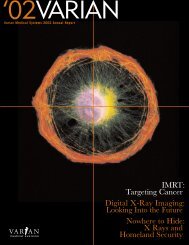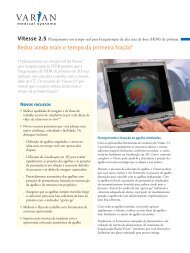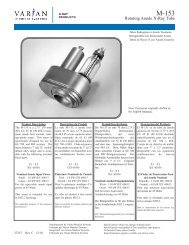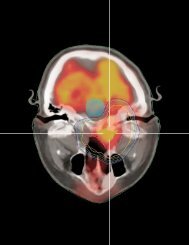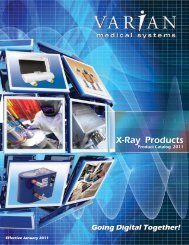Varian Linatron High-Energy X-ray Applications 2007
Varian Linatron High-Energy X-ray Applications 2007
Varian Linatron High-Energy X-ray Applications 2007
Create successful ePaper yourself
Turn your PDF publications into a flip-book with our unique Google optimized e-Paper software.
Optical disks are classified as non-volatile because they can<br />
be written to once, read as many times as desired and<br />
cannot be erased. Therefore, optical disks are the digital<br />
equivalent to standard film. Additionally, optical disks have<br />
a very high capacity. Present optical disks can store up to<br />
8000 images per disk pack. Since disk packs are removable,<br />
virtually unlimited storage is possible.<br />
Hard disk storage is usually an intermediate digital storage<br />
before transferring the images to optical disk, magnetic<br />
tape or floppy diskette. This is because the hard disk has a<br />
definite limit on storage capacity. Therefore, image data<br />
must be regularly erased to make room for more data.<br />
Operator Control - Early real-time radiography system<br />
operator controls were a collection of the individual<br />
component controls mounted on an operators console.<br />
The trend for present systems is to integrate all of the<br />
controls from the separate components that make up a<br />
real-time system into one centralized control system. This<br />
is most often accomplished by controlling all system<br />
components with a centralized computer system.<br />
Today it is possible to use a real-time radiography system as<br />
the control core of an automated radiographic inspection<br />
system. This requires communication and control<br />
protocols between the imaging system and the parts<br />
handling device (manipulator) - and possibly other<br />
peripherals - and the ability for the imaging system to<br />
perform programmable inspection sequences. Then, after<br />
the part is loaded and the x-<strong>ray</strong> source and camera are<br />
aligned to an initial position, the control computer can<br />
control the rest of the inspection process.<br />
<strong>Applications</strong><br />
Real-time radiography applications can be generally<br />
divided into two subsections, actual real-time imaging<br />
where processes are examined for dynamic function and<br />
automated test sequences where high test throughput and<br />
low-cost is the primary function.<br />
Test procedures such as observing the pattern of metal<br />
filling molds and observing the function of motor<br />
components while the motor is actually running are typical<br />
dynamic function applications. It is also often necessary to<br />
use real-time systems to properly position test objects<br />
where the inner mechanism is unknown or obscure.<br />
page 55<br />
Automated testing has become more important in recent<br />
times because of an emphasis upon 100% testing of critical<br />
components. Real time systems, in conjunction with parts<br />
handling systems (manipulators) and integrated system<br />
control, allow automated test sequencing with higher<br />
throughputs and more coverage than previous film systems.<br />
Figure 6-3 illustrated a real-time automated inspection<br />
system.<br />
The following characteristics should be considered when<br />
planning a real-time radiography application:<br />
X-<strong>ray</strong> energy - Selection of an x-<strong>ray</strong> energy for real-time<br />
imaging should be based upon several considerations.<br />
Selection of an energy that is too great for the part being<br />
inspected can lead to difficulties. When the energy is so<br />
high that the material does not present at least 1.5 half<br />
value layers, small changes in attenuation may be lost.<br />
Additionally, radiation buildup can cause tremendous<br />
scatter problems when x-<strong>ray</strong>ing thin sections. This is<br />
stabilized after approximately 1.5 HVLs. This thickness is<br />
called the “equilibrium” thickness.<br />
Selecting too low an energy also presents problems,<br />
especially when actual real-time images are important. In<br />
general, dynamic real-time radiography is like taking<br />
pictures at a thirtieth of a second per image. If the<br />
radiation energy or output is too low, little detail will be<br />
seen in the image. This imaging time can be lengthened by<br />
averaging two or more frames together. However, enough<br />
radiation must be reaching the imaging screen to provide<br />
the amount of light on the conversion screen needed for<br />
proper image evaluation.<br />
Ideally, x-<strong>ray</strong> energy and output is chosen so that 4 to 7<br />
half value layers are being examined and the radiation to<br />
the imaging screen exceeds 15 to 25 rads/min. However,<br />
real-time systems can be useful at extremes outside of this<br />
ideal envelope.<br />
<strong>Varian</strong> <strong>Linatron</strong> applications


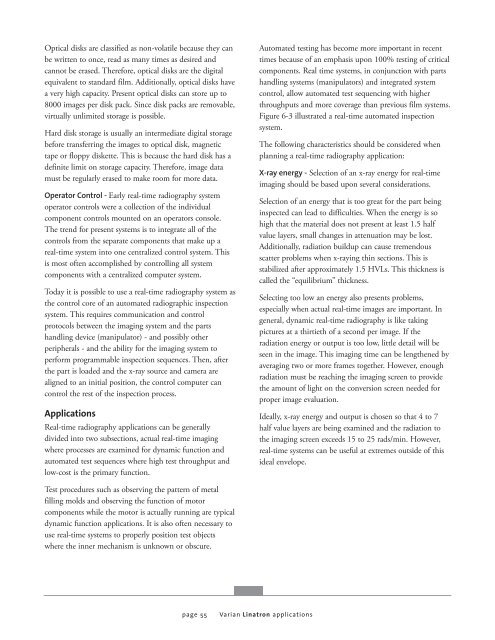



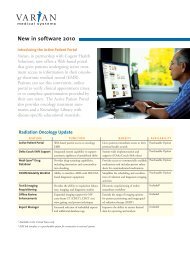
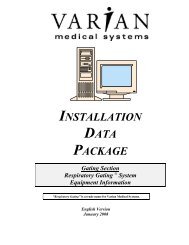


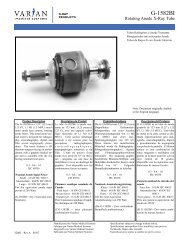
![[MSDS 126] Dow Corning 200 Fluid, 5 CST Part Number ... - Varian](https://img.yumpu.com/5104917/1/190x245/msds-126-dow-corning-200-fluid-5-cst-part-number-varian.jpg?quality=85)

